
Morocco, Africa
by Ellen Johnston
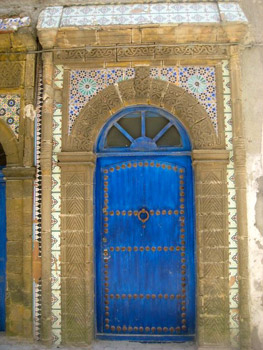 Some people will try to tell you that this is not Africa. Morocco, located on the continent’s northwestern edge, is something of an enigma in this regard. Its people are mostly descended from Arab invaders and indigenous Berbers, whose DNA and culture are closer to that of Mediterranean Europe than anything below the Sahara. But when the Gnaoua World Music Festival kicks off every June in Essaouira, on Morocco’s Atlantic coast, its African heart emerges – beating strongly to the rhythms of the drums and three-string basses of the West African slaves who arrived here centuries ago.
Some people will try to tell you that this is not Africa. Morocco, located on the continent’s northwestern edge, is something of an enigma in this regard. Its people are mostly descended from Arab invaders and indigenous Berbers, whose DNA and culture are closer to that of Mediterranean Europe than anything below the Sahara. But when the Gnaoua World Music Festival kicks off every June in Essaouira, on Morocco’s Atlantic coast, its African heart emerges – beating strongly to the rhythms of the drums and three-string basses of the West African slaves who arrived here centuries ago.
It’s no secret that the Arabs were prolific slave traders, even worse, some say, than the Europeans who transported Africans to the New World. And like those who went to the Americas, Morocco’s slaves brought their music with them. Over time, they formed Sufi brotherhoods, combining the trance worship of mystical Islam with the pre-Islamic traditions of their sub-Saharan homelands. Their music is ecstatic, characterized by call-and-response, ritual and repetition. Songs can last hours, invoking spiritual entities, called jnoun, to possess the worshipers. To the Gnaoua, personal connection to the divine is central, so rapturous and uncontrollable dancing is expected. Their music embraces several worlds: the physical and the spiritual, and the Arab and the African – not only through the musicians’ ancestry, but through the music’s flattened pitches reminiscent of the blues, and in the steady beating of the krakebs, metal castanets shaped like the handcuffs of their slave ancestors.
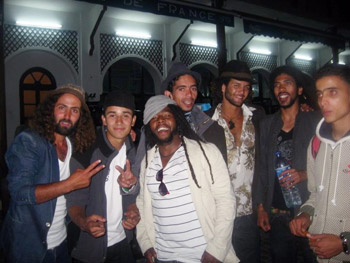 Gnaoua music is alive and well in Morocco today, though its spiritual origins have been somewhat lost through its own popularity. It’s not just the Sufis who perform Gnaoua music anymore. It’s played in clubs by fusion bands, and on world tours by famous musicians interested in cross-cultural connections. But most significantly, it has become the centerpiece of one of Morocco’s biggest festivals, a four-day event that takes place at the beginning of every summer.
Gnaoua music is alive and well in Morocco today, though its spiritual origins have been somewhat lost through its own popularity. It’s not just the Sufis who perform Gnaoua music anymore. It’s played in clubs by fusion bands, and on world tours by famous musicians interested in cross-cultural connections. But most significantly, it has become the centerpiece of one of Morocco’s biggest festivals, a four-day event that takes place at the beginning of every summer.
 Some call it the Woodstock of Africa, while others claim it has become too corporate. Founded seventeen years ago, the Gnaoua World Music Festival (known officially by its French name, Le Festival Gnaoua et des musiques du Monde d’Essaouira) attracts over 300,000 people, who not only come to hear Gnaoua music, but also sounds from all over Africa. A lot of the crowd is European, not just hippie-types but also music enthusiasts, wind surfers, and those on cheap breaks. But there are a lot of Moroccans here too, who can afford to come because most of the concerts are free, running late into the night on the town’s beaches.
Some call it the Woodstock of Africa, while others claim it has become too corporate. Founded seventeen years ago, the Gnaoua World Music Festival (known officially by its French name, Le Festival Gnaoua et des musiques du Monde d’Essaouira) attracts over 300,000 people, who not only come to hear Gnaoua music, but also sounds from all over Africa. A lot of the crowd is European, not just hippie-types but also music enthusiasts, wind surfers, and those on cheap breaks. But there are a lot of Moroccans here too, who can afford to come because most of the concerts are free, running late into the night on the town’s beaches.
 Essaouira is known as the windy city, though it bears other names too: the Portuguese, who laid the foundations for the town we see today, called it Mogador, and its Berber name simply means “the wall”. It’s a fortified city with walls that keep out the wind, and also much of modernity. The medina at its centre is labyrinthine and painted almost entirely in white and blue. Gnaoua music permeates the streets, even outside of festival time, and other hallmarks of Moroccan life are there too: traditional hammams (spas), markets, a souk devoted entirely to wood artisans, an old Jewish synagogue (a reminder that Essaouira was once 40% Jewish) and cafés that serve simple, yet delicious fare (always, of course, accompanied by mint tea). These are the best places to eat, especially if you’re on a budget and want to nosh like the locals. Bowls of lentils, spiced with cumin, paprika, and laced with meat, can be bought for as little as 6 dirhams (around 75 cents), and are served with bread, for free. White beans are a similarly delicious bargain, though if you’re feeling a bit more luxurious, fish is the best thing to eat in Essaouira. Kefta, traditional Moroccan meatballs, stuffed with onions and parsley, are delectable too, but sardines, bought fresh from the fishermen down by the beach are even better. Once bought, you can take the fish to a restaurant to be cooked on the spot, often with traditional chermoula sauce (a mixture of cilantro, parsley, chili, lemon, olive oil and spices).
Essaouira is known as the windy city, though it bears other names too: the Portuguese, who laid the foundations for the town we see today, called it Mogador, and its Berber name simply means “the wall”. It’s a fortified city with walls that keep out the wind, and also much of modernity. The medina at its centre is labyrinthine and painted almost entirely in white and blue. Gnaoua music permeates the streets, even outside of festival time, and other hallmarks of Moroccan life are there too: traditional hammams (spas), markets, a souk devoted entirely to wood artisans, an old Jewish synagogue (a reminder that Essaouira was once 40% Jewish) and cafés that serve simple, yet delicious fare (always, of course, accompanied by mint tea). These are the best places to eat, especially if you’re on a budget and want to nosh like the locals. Bowls of lentils, spiced with cumin, paprika, and laced with meat, can be bought for as little as 6 dirhams (around 75 cents), and are served with bread, for free. White beans are a similarly delicious bargain, though if you’re feeling a bit more luxurious, fish is the best thing to eat in Essaouira. Kefta, traditional Moroccan meatballs, stuffed with onions and parsley, are delectable too, but sardines, bought fresh from the fishermen down by the beach are even better. Once bought, you can take the fish to a restaurant to be cooked on the spot, often with traditional chermoula sauce (a mixture of cilantro, parsley, chili, lemon, olive oil and spices).
 In festival time, the concerts mostly take place on the beaches, but also spill out into the clubs of the new city, located outside the old medina walls. There are events for every taste, though the biggest, most exciting shows happen outdoors on the free stages. Music runs pretty much all night, which not only creates a 24/7 party atmosphere, but also provides a welcome relief to the mid-day temperatures of the Moroccan summer. Essaouira is less hot than Marrakech, thanks to ocean breezes, but high noon temperatures are still nothing to laugh at. The nighttime is cool, perfect weather for dancing to the beats of the Sufi Brotherhoods or visiting world musicians. And dance you will. This is Africa, remember, albeit a much less traditional, more open-minded version of the continent than you might experience elsewhere. Vendors circulate throughout the concert space, selling donuts and other tasty treats. More savory fare can be bought from makeshift stands on the perimeter, selling corn, fish, hard boiled eggs with cumin and salt, and pastries. Alcohol is not obviously easy to procure, but despite what the hustlers might try to tell you (searching for a commission), there are several liquor depots in the new city where you can buy alcohol at a fixed price. It’s very common to see both tourists and locals imbibing on the beach, though usually out of water bottles, often containing the local firewater.
In festival time, the concerts mostly take place on the beaches, but also spill out into the clubs of the new city, located outside the old medina walls. There are events for every taste, though the biggest, most exciting shows happen outdoors on the free stages. Music runs pretty much all night, which not only creates a 24/7 party atmosphere, but also provides a welcome relief to the mid-day temperatures of the Moroccan summer. Essaouira is less hot than Marrakech, thanks to ocean breezes, but high noon temperatures are still nothing to laugh at. The nighttime is cool, perfect weather for dancing to the beats of the Sufi Brotherhoods or visiting world musicians. And dance you will. This is Africa, remember, albeit a much less traditional, more open-minded version of the continent than you might experience elsewhere. Vendors circulate throughout the concert space, selling donuts and other tasty treats. More savory fare can be bought from makeshift stands on the perimeter, selling corn, fish, hard boiled eggs with cumin and salt, and pastries. Alcohol is not obviously easy to procure, but despite what the hustlers might try to tell you (searching for a commission), there are several liquor depots in the new city where you can buy alcohol at a fixed price. It’s very common to see both tourists and locals imbibing on the beach, though usually out of water bottles, often containing the local firewater.
 The festival atmosphere pervades the city, and not just at night on the beaches by the big music stages. It’s on the streets in the daytime too, in the official processions of the Gnaoua musicians, and in the unofficial parades of young Moroccan rastas, Spanish girls in harem pants, the old Djellaba-clad (a traditional Moroccan robe) hooked-nose man who haunts the medina and claims to have worked for Cat Stevens, and in the gentle giant dancing manically to the beat of his own drummer. In fact, the festival atmosphere begins the moment you step on the bus to Essaouira. Buses run regularly between Marrakech and the port, and tickets can be bought either directly from the ticket office inside the bus station, or from hustlers outside, who may or may not offer you a better price, albeit probably on a worse bus. But a lower class bus is not a guarantee of a bad experience. In fact, you’re more likely to meet locals that way, locals who, unlike many people you meet on the street, will give you advice for free. Some might recommend a place to stay or eat salty grilled fish, while others will try to convince you of their love for Bob Marley, or may even offer you hashish or wine mixed with cola – both of which maintain various levels of illegality for Moroccans, though each proliferate at the festival. But for most attendees, the music on its own is transcendent enough: beautiful and ancient as it floats above the storied corners of the medina, past the spice sellers and fishing boats, and out to sea.
The festival atmosphere pervades the city, and not just at night on the beaches by the big music stages. It’s on the streets in the daytime too, in the official processions of the Gnaoua musicians, and in the unofficial parades of young Moroccan rastas, Spanish girls in harem pants, the old Djellaba-clad (a traditional Moroccan robe) hooked-nose man who haunts the medina and claims to have worked for Cat Stevens, and in the gentle giant dancing manically to the beat of his own drummer. In fact, the festival atmosphere begins the moment you step on the bus to Essaouira. Buses run regularly between Marrakech and the port, and tickets can be bought either directly from the ticket office inside the bus station, or from hustlers outside, who may or may not offer you a better price, albeit probably on a worse bus. But a lower class bus is not a guarantee of a bad experience. In fact, you’re more likely to meet locals that way, locals who, unlike many people you meet on the street, will give you advice for free. Some might recommend a place to stay or eat salty grilled fish, while others will try to convince you of their love for Bob Marley, or may even offer you hashish or wine mixed with cola – both of which maintain various levels of illegality for Moroccans, though each proliferate at the festival. But for most attendees, the music on its own is transcendent enough: beautiful and ancient as it floats above the storied corners of the medina, past the spice sellers and fishing boats, and out to sea.

Full-Day Tour to Essaouira – The Ancient Mogador City from Marrakech
If You Go:
♦ Accommodation can become much more expensive and much harder to find the closer it is to festival time, so be sure to book ahead!
♦ More information about the festival, including the official program can be found at www.festival-gnaoua.net
♦ If you’re planning on taking the bus from Marrakech, the bus station (known as the gare routière) is located just outside the medina’s walls at Bab Doukkala. Depending on whether you buy from the official office, or haggle with a vendor outside, your ticket should cost between 6 and 9 dollars.
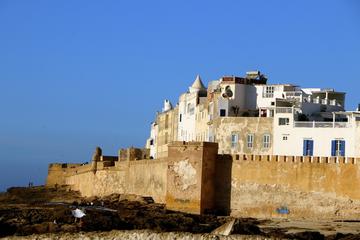
Private Day Trip to Essaouira from Marrakech
About the author:
Ellen Johnston is a cultural nomad — a traveller, writer and musician who bounces all over the world. Originally from Vancouver, Canada, she has West Coast roots, a Mediterranean soul and a Chilanga heart, thanks to a recent stint in the Mexican capital. She can presently be found dipping her toes in the Caribbean waters of Quintana Roo. You can find links to her other writing and photography at www.ambiguoustraveller.wordpress.com
All photos are by Ellen Johnston.


 Unfortunately we have no time to bargain and buy souvenirs this morning. We’re on our way to board a boat that will take us to visit the island temple of Philae. Hanan, the Egyptologist explains, “These dark-skinned people are Nubians. They live in settlements along the river.” She tells us that because of the lack of tourists due to recent political unrest, these souvenir hawkers and boatmen are struggling to make a living. Hanan points out a settlement of yellow brick houses clustered under a sandy hill across the river. “That is one of their villages. They call it ‘Elephantine’, perhaps because the hill is shaped like an elephant.”
Unfortunately we have no time to bargain and buy souvenirs this morning. We’re on our way to board a boat that will take us to visit the island temple of Philae. Hanan, the Egyptologist explains, “These dark-skinned people are Nubians. They live in settlements along the river.” She tells us that because of the lack of tourists due to recent political unrest, these souvenir hawkers and boatmen are struggling to make a living. Hanan points out a settlement of yellow brick houses clustered under a sandy hill across the river. “That is one of their villages. They call it ‘Elephantine’, perhaps because the hill is shaped like an elephant.” With our handsome young Nubian boatman at the helm we sail down the river. These boatmen are renowned for their skill as skippers and fishermen. Most of the small craft including the feluccas that sail on the Nile are commandeered by Nubians. The Nile is a vast river, much wider than I’d expected, and fast flowing.
With our handsome young Nubian boatman at the helm we sail down the river. These boatmen are renowned for their skill as skippers and fishermen. Most of the small craft including the feluccas that sail on the Nile are commandeered by Nubians. The Nile is a vast river, much wider than I’d expected, and fast flowing. Nubia was always a land of mystery and legend. Many of the pharaohs of ancient times were Nubians. At the site of Memphis and Karnak there are Nubian monuments. In 747 BC the city of Thebes, near Karnak, was besieged and the Egyptians called on the Nubian king for protection. Thebes was rescued and for the next 100 years Nubian kings ruled in Egypt. Archaeologists have worked to excavate as many ancient sites as possible and managed to save over 5000 Nubian objects but many of the Nubian treasures still lie beneath the waters of Lake Nasser. One of the archaeological sites that was rescued and restored is Abu Simbal, at the far end of Lake Nasser. Another is the Temple of Philae, restored on a small rocky island once known as Apo, which means “ivory”.
Nubia was always a land of mystery and legend. Many of the pharaohs of ancient times were Nubians. At the site of Memphis and Karnak there are Nubian monuments. In 747 BC the city of Thebes, near Karnak, was besieged and the Egyptians called on the Nubian king for protection. Thebes was rescued and for the next 100 years Nubian kings ruled in Egypt. Archaeologists have worked to excavate as many ancient sites as possible and managed to save over 5000 Nubian objects but many of the Nubian treasures still lie beneath the waters of Lake Nasser. One of the archaeological sites that was rescued and restored is Abu Simbal, at the far end of Lake Nasser. Another is the Temple of Philae, restored on a small rocky island once known as Apo, which means “ivory”. The boat rounds a bend in the river past a mound of giant stones that stand like a sentinel. Not far ahead I see the sand-stone buildings of the Temple of Philae fringed by a stand of palm trees.
The boat rounds a bend in the river past a mound of giant stones that stand like a sentinel. Not far ahead I see the sand-stone buildings of the Temple of Philae fringed by a stand of palm trees.
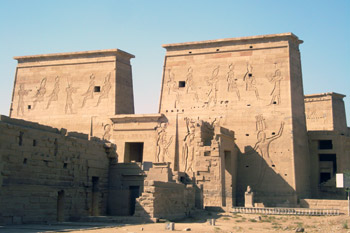 The temple complex was built during the Ptolemaic dynasty (380-362 BC). Its principal deity was Isis but there are shrines dedicated to other gods. The most ancient temple was one built for Isis, the goddess to whom the first buildings were dedicated. It was approached from the river through a double colonnade. Because it was supposed to be the burial place of Isis’s husband, Osiris, Philae was held in great reverence both by the Egyptians to the north and the Nubians in the south. Only priests could dwell there. On the walls inscriptions tell the story of Osiris and how he was murdered.
The temple complex was built during the Ptolemaic dynasty (380-362 BC). Its principal deity was Isis but there are shrines dedicated to other gods. The most ancient temple was one built for Isis, the goddess to whom the first buildings were dedicated. It was approached from the river through a double colonnade. Because it was supposed to be the burial place of Isis’s husband, Osiris, Philae was held in great reverence both by the Egyptians to the north and the Nubians in the south. Only priests could dwell there. On the walls inscriptions tell the story of Osiris and how he was murdered.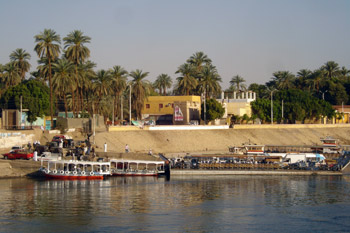 The Philae temple was closed in the 6thcentury AD by the Byzantine emperor Justinian. After that it became a seat of the Christian religion. Ruins of a Christian church were discovered on the site. Many of the sculptures and hieroglyphics on the walls of the temple were destroyed or mutilated by these early Christian inhabitants. Most of Horus’s statues were left unmarred but in many of the wall scenes, every figure is scratched out except that of Horus and his winged solar-disk, perhaps because the Byzantine Christians saw some parallel between Horus, the god’s son, and the stories of Jesus.
The Philae temple was closed in the 6thcentury AD by the Byzantine emperor Justinian. After that it became a seat of the Christian religion. Ruins of a Christian church were discovered on the site. Many of the sculptures and hieroglyphics on the walls of the temple were destroyed or mutilated by these early Christian inhabitants. Most of Horus’s statues were left unmarred but in many of the wall scenes, every figure is scratched out except that of Horus and his winged solar-disk, perhaps because the Byzantine Christians saw some parallel between Horus, the god’s son, and the stories of Jesus.


 It took two hours to travel the twelve kilometers from downtown Nairobi to Blixen’s farm. The main highway, currently being re-built by the Chinese government, was under heavy construction. Whatever romance I had expected was wiped out by the intense drive. Horns blared. Thick smog reeked of car fumes. Engines idled without any forward movement. Men selling everything from magazines to bananas pressed up against the car. My driver advised me to keep my window closed so I wouldn’t be robbed. With one of the highest crime rates in Africa, Nairobi has the infamous nickname “Now rob me”.
It took two hours to travel the twelve kilometers from downtown Nairobi to Blixen’s farm. The main highway, currently being re-built by the Chinese government, was under heavy construction. Whatever romance I had expected was wiped out by the intense drive. Horns blared. Thick smog reeked of car fumes. Engines idled without any forward movement. Men selling everything from magazines to bananas pressed up against the car. My driver advised me to keep my window closed so I wouldn’t be robbed. With one of the highest crime rates in Africa, Nairobi has the infamous nickname “Now rob me”.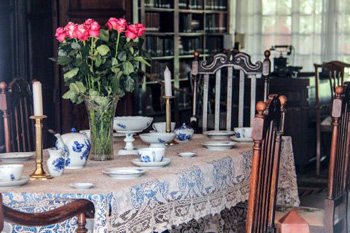 Still, as we drove up the laneway, my palms grew damp and I felt anxious, like I was meeting someone I had not seen in several years and was worried about making a good impression. Such is the odd relationship between a reader, a novel and the novelist. The reader feels a tenderness that is one-sided. Loving a novel is always unrequited.
Still, as we drove up the laneway, my palms grew damp and I felt anxious, like I was meeting someone I had not seen in several years and was worried about making a good impression. Such is the odd relationship between a reader, a novel and the novelist. The reader feels a tenderness that is one-sided. Loving a novel is always unrequited. When I opened my door, the spicy smell of Cypress stung my nostrils. Norfolk pines and columnar cypress lined the immaculate grounds. Cultivated shrubs with fushia foliage bordered the front lawn. Delicate blue flowers opened to the cloudless sky. The wide lawn stretched across the front and the back of the house. There was a lot of activity as workers erected great white tents in the backyard for a craft fair on the weekend. The property is popular for weddings and special events.
When I opened my door, the spicy smell of Cypress stung my nostrils. Norfolk pines and columnar cypress lined the immaculate grounds. Cultivated shrubs with fushia foliage bordered the front lawn. Delicate blue flowers opened to the cloudless sky. The wide lawn stretched across the front and the back of the house. There was a lot of activity as workers erected great white tents in the backyard for a craft fair on the weekend. The property is popular for weddings and special events.
 I walked into the bedroom. There was a tiny, white bed with a hard looking mattress. A pair of riding boots stood in the centre of the room. Several British tourists shuffled in behind me following their guide. They had paid for a tour and were fans of the 1985 movie, based on the novel, starring Meryl Streep as Karen Blixen and Robert Redford as Denys Finch Hatton, her lover. The guide began his spiel.
I walked into the bedroom. There was a tiny, white bed with a hard looking mattress. A pair of riding boots stood in the centre of the room. Several British tourists shuffled in behind me following their guide. They had paid for a tour and were fans of the 1985 movie, based on the novel, starring Meryl Streep as Karen Blixen and Robert Redford as Denys Finch Hatton, her lover. The guide began his spiel.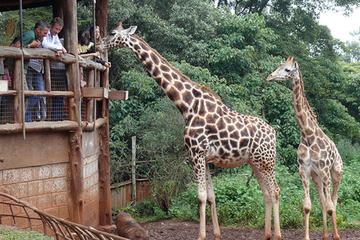

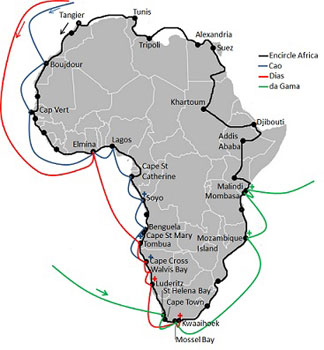
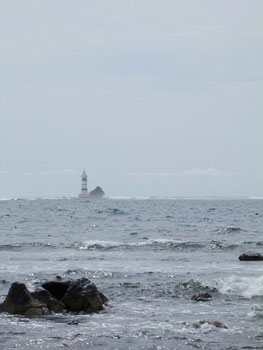 The padrãos had several intentions, as did the voyages around the African continent themselves. Portugal, surrounded by hostile kingdoms, turned to the sea to find a new route to India’s spice trade that eliminated greedy middle men. The padrãos not only acted as navigational aids, but proclaimed the land around them as Christian, and belonging to the Kingdom of Portugal. They were also a handy source of ballast, generally only positioned on a voyage’s homeward journey. The carved inscription on the Cape Cross padrão reads: “In the year…1485 after the birth of Christ, the most excellent and serene king Dom John II of Portugal ordered this land to be discovered and this padrão to be placed by Diogo Cao”.Namibia’s Cape Cross was Cao’s journeys end. The next 15 years would see countrymen Bartolomeu Dias and Vasco da Gama forge a sea route to India’s Malabar Coast. Each explorer was dependent upon the discoveries of those who had gone before and the padrãos they had positioned.
The padrãos had several intentions, as did the voyages around the African continent themselves. Portugal, surrounded by hostile kingdoms, turned to the sea to find a new route to India’s spice trade that eliminated greedy middle men. The padrãos not only acted as navigational aids, but proclaimed the land around them as Christian, and belonging to the Kingdom of Portugal. They were also a handy source of ballast, generally only positioned on a voyage’s homeward journey. The carved inscription on the Cape Cross padrão reads: “In the year…1485 after the birth of Christ, the most excellent and serene king Dom John II of Portugal ordered this land to be discovered and this padrão to be placed by Diogo Cao”.Namibia’s Cape Cross was Cao’s journeys end. The next 15 years would see countrymen Bartolomeu Dias and Vasco da Gama forge a sea route to India’s Malabar Coast. Each explorer was dependent upon the discoveries of those who had gone before and the padrãos they had positioned.
 I didn’t get close enough to feel their influence until reaching Soyo on Angola’s northern border, the southern bank of the River Congo, four months after beginning. It took Cao about the same length of time by sail. Even then I was unable to find the fragmentary remains of his padrão which are said to exist.
I didn’t get close enough to feel their influence until reaching Soyo on Angola’s northern border, the southern bank of the River Congo, four months after beginning. It took Cao about the same length of time by sail. Even then I was unable to find the fragmentary remains of his padrão which are said to exist.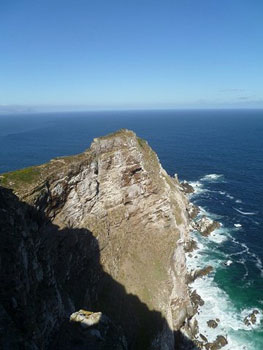 Dias used Cao’s discoveries to continue, taking anchor 75 miles further south at Walvis Bay, a town still dependent on ships anchoring today. On its outskirts, monumental stylized rigged ships celebrate the town’s earlier European visitor.
Dias used Cao’s discoveries to continue, taking anchor 75 miles further south at Walvis Bay, a town still dependent on ships anchoring today. On its outskirts, monumental stylized rigged ships celebrate the town’s earlier European visitor.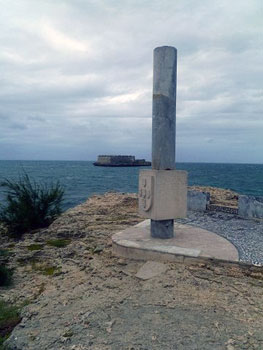 From Mossel Bay da Gama faced unknown seas, passing Dias’ endpoint on December 16 1497. It was coming up to Christmas, so the coast da Gama spotted on his left hand side was named Natal (birth). His four caravels continued up the East coast of Africa eventually reaching Mozambique Island. Here on the island’s eastern end, facing a small, later Portuguese fort, I encountered the remains of his padrão. This was the closest I had come so far to one of the original navigational aids.
From Mossel Bay da Gama faced unknown seas, passing Dias’ endpoint on December 16 1497. It was coming up to Christmas, so the coast da Gama spotted on his left hand side was named Natal (birth). His four caravels continued up the East coast of Africa eventually reaching Mozambique Island. Here on the island’s eastern end, facing a small, later Portuguese fort, I encountered the remains of his padrão. This was the closest I had come so far to one of the original navigational aids.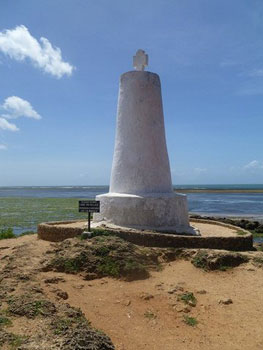 My search for the Portuguese explorers was finally over. I took a three-wheeled tuktuk to the padrão. The intervening years between me and da Gama had not been kind to it. Instead of the slim column of Lisbon limestone, it had been variously altered so it now resembled a giant white traffic cone topped with a Greek cross. Yet there it still stands on a rocky outcrop. One of the only original Portuguese padrãos I had been able to find during my own exploration of Africa 500 years on. From here da Gama went across the ocean to India. His mission complete, he returned home to report his successes to the king of Portugal. I still had to cross to Egypt, and follow the Mediterranean back to Tangier to Encircle Africa.
My search for the Portuguese explorers was finally over. I took a three-wheeled tuktuk to the padrão. The intervening years between me and da Gama had not been kind to it. Instead of the slim column of Lisbon limestone, it had been variously altered so it now resembled a giant white traffic cone topped with a Greek cross. Yet there it still stands on a rocky outcrop. One of the only original Portuguese padrãos I had been able to find during my own exploration of Africa 500 years on. From here da Gama went across the ocean to India. His mission complete, he returned home to report his successes to the king of Portugal. I still had to cross to Egypt, and follow the Mediterranean back to Tangier to Encircle Africa.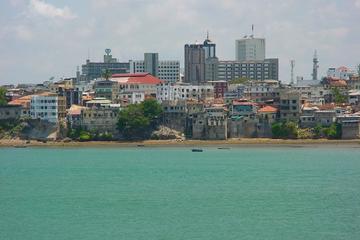
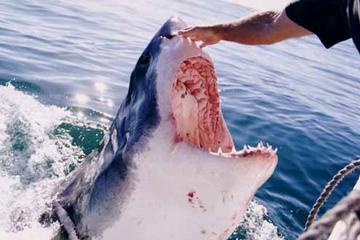
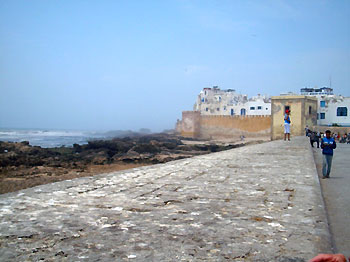
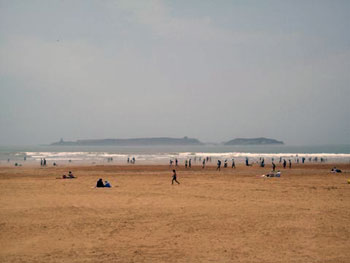 The present city with its much admired walls and Medina is a creation, a purpose built sea port, commissioned by King Mohammed III during the 18th century. He wanted to develop trade with Europe and beyond and to establish a counterbalance to Agadir, whose inhabitants favored a rival of him. For twelve years, the king instructed and oversaw French engineer and architect Theodore Cornut, who designed the modern city, the medina and the international quarters. At the time, Morocco depended heavily on the caravan trade, which brought merchandise from sub-Saharan Africa to Timbuktu, then from there through the desert and over the Atlas mountains to Marrakesh and, finally, making use of the straight road, to the thriving port of Essaouira.
The present city with its much admired walls and Medina is a creation, a purpose built sea port, commissioned by King Mohammed III during the 18th century. He wanted to develop trade with Europe and beyond and to establish a counterbalance to Agadir, whose inhabitants favored a rival of him. For twelve years, the king instructed and oversaw French engineer and architect Theodore Cornut, who designed the modern city, the medina and the international quarters. At the time, Morocco depended heavily on the caravan trade, which brought merchandise from sub-Saharan Africa to Timbuktu, then from there through the desert and over the Atlas mountains to Marrakesh and, finally, making use of the straight road, to the thriving port of Essaouira.
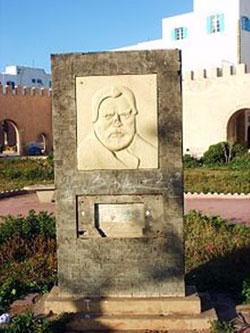 The long stretched island of Mogador protects Essaouira from the strongest Atlantic winds, but there is still plenty around to make the place a paradise for surfers and kite surfers. The wide, white beaches invite to sunbathing, swimming and any other imaginable kind of water sport.
The long stretched island of Mogador protects Essaouira from the strongest Atlantic winds, but there is still plenty around to make the place a paradise for surfers and kite surfers. The wide, white beaches invite to sunbathing, swimming and any other imaginable kind of water sport. Small wonder that this picturesque, sedate and slightly melancholic city attracted such divers personalities as Churchill, Welles and Hendrix. Orson Welles even got honored with a statue, although his nose is now missing.
Small wonder that this picturesque, sedate and slightly melancholic city attracted such divers personalities as Churchill, Welles and Hendrix. Orson Welles even got honored with a statue, although his nose is now missing.
